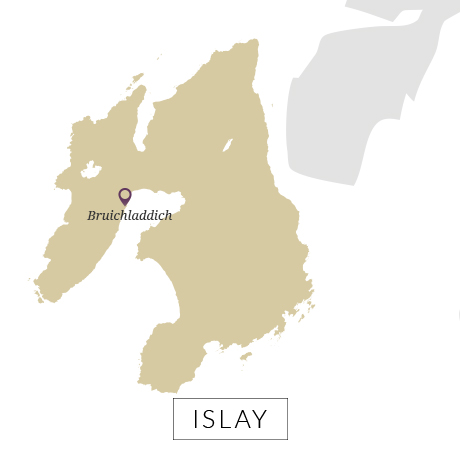Octomore
The most routinely heavily-peated malt.


Bruichladdich’s character is sweet, honeyed and floral with a lemon-butter note and an unmistakable freshness. Since 2000, however, other variants have been made – medium-peated Port Charlotte and heavily-peated Octomore. While both are defiantly smoky with plenty of rich, bonfire-like aromas, the inherent freshness and acidity of the distillery character is retained.
Experiments have also taken place with different barley varieties (including the archaic Bere) and a long-term project is currently under way, with local farmers once again planting the crop for the first time since the turn of the 20th century. More than 40% of Bruichladdich’s malting barley is now produced on the island.
In addition, an old Lomond still has been recommissioned and produces The Botanist gin, whose botanical mix includes herbs and plants from Islay.

Bruichladdich may have been described as ‘a working distillery museum’, but in its day it was one of Islay’s most modern plants – and today is one of Scotland’s most innovative. It was built in 1881 by the Harvey brothers, who owned the Dundashill and Yoker grain distilleries in Glasgow. Like all of the late Victorian plants, its fortunes were inextricably linked to blends from the outset.
In 1937, the eccentric Joseph Hobbs (see Ben Nevis) picked it up, but by 1954 it become part of DCL, which quickly offloaded it to AB Grant.
In 1968, Invergordon – whose business was predominantly bulk supplies – became its owner and, after a period of reduced production in the 1980s, it became part of Whyte & Mackay’s portfolio through a merger in 1993. Deemed to be surplus to requirements, the Glasgow firm closed it down in 1995 and it remained silent until 2001 when a group of Islay landowners and a London-based wine merchant bought it for £6 million.
At this point the distillery was transformed. None of the previous owners had modernised the equipment and the new parents couldn’t afford a significant upgrade, so ‘the old lady of Islay’ was nursed back to health. The money was desperately needed elsewhere.
Years of producing bulk had resulted in a less than quality-oriented wood policy, which necessitated re-racking some casks into fresh wood, including a huge range of ex-wine and fortified wine casks. Further investment went into the building of the bottling line (which employs people from the island).
Experimentation and innovation continued – multiple distillates, gin, finishing, local barley – before in 2012 Rémy Cointreau bought Bruichladdich for £58m. This made investment in new plant and machinery possible, and in the intervening years additional warehousing has been built on Islay.
In April 2019, Bruichladdich unveiled plans to build its own maltings (although much of its barley is grown on Islay, currently it is sent to Inverness for malting). The distillery has also bought 30 acres of nearby farmland to conduct barley trials and test sustainable farming practices.



 Brand
Brand
A heavily peated single malt, distilled on the Isle of Islay at Bruichladdich distillery.


 Distillery
Distillery
The lost Islay distillery of Ballygrant was but a fleeting part of the island’s history.